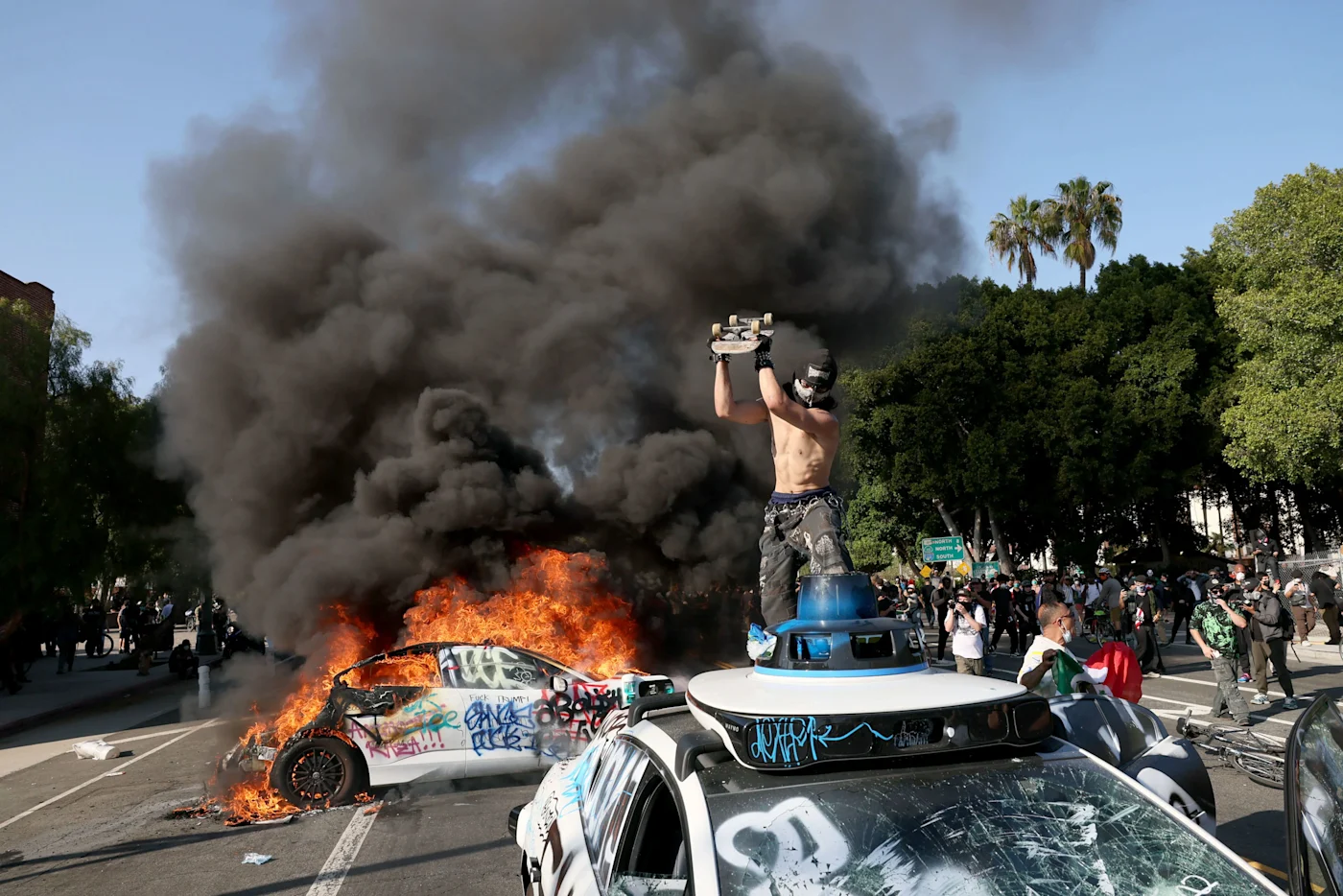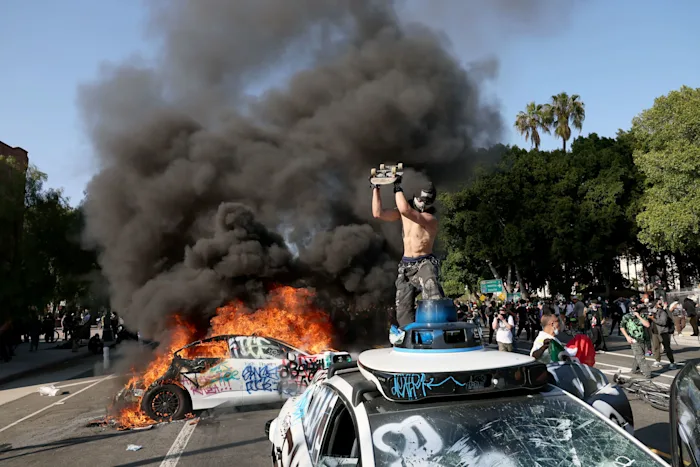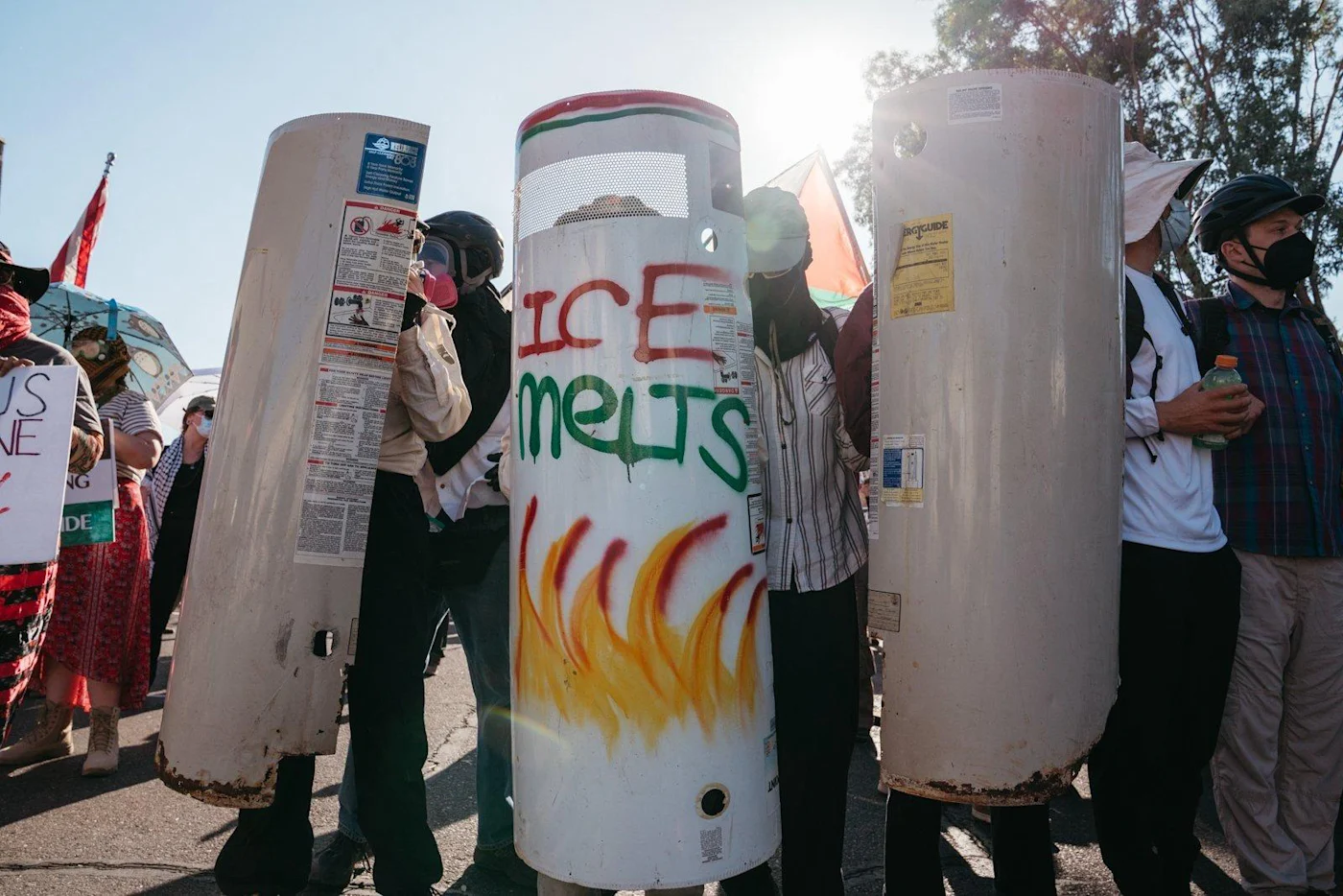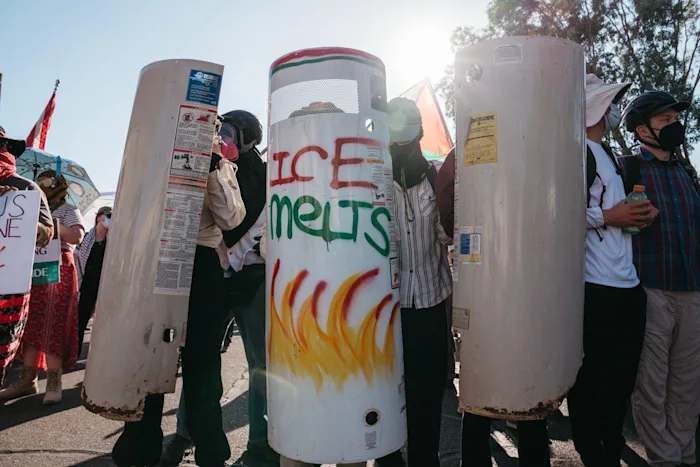Fire and Ice:
Lessons from the Battle of Los Angeles
Anonymous
A printable zine version can be downloaded here.
Other languages: Français, Español, Português
I think I’ll stay on this earthquake fault near this still-active volcano in this armed fortress facing a dying ocean & covered w/dirt while the streets burn up & the rocks fly & pepper gas lays us out cause that’s where my friends are, you bastards, not that you know what that means. —Diane Di Prima, “Revolutionary Letter #52”
Momentum in the movement against mass deportations had been building for weeks. From San Diego to Martha’s Vineyard, spontaneous confrontations with ICE agents were already happening. Alongside that, there had been coordinated actions of activists and rapid response networks, including efforts to blockade ICE vans in downtown Manhattan.
Everyone knew it was about to explode. Then, in Los Angeles, it finally happened. Crowds gathered in response to ICE raids in several neighborhoods. This was followed by protests night after night outside of the Metropolitan Detention Center, where arrested migrants were being held.
Efforts to blockade ICE raids and the detention center led to clashes with the police. Crowds spread throughout downtown and other neighborhoods. Protesters blocked streets and highways, fought police with stones and fireworks, built barricades, and set several cars on fire. On Sunday night, the chief of police announced that the LAPD was overwhelmed. Trump had already decided to send in the National Guard and, soon after, the Marines.
The explosion was always going to begin in Los Angeles. But now that the fire has started, it is beginning to expand. Protests have spread to dozens of cities across the country. Upwards of a thousand arrests, and counting. Texas and Missouri have deployed the National Guard.
Unrest has now spread inside immigrant detention centers. A riot inside of Delaney Hall Detention Facility in Newark, New Jersey led to several migrants tearing down a wall and escaping. The detention center, which has just reopened, might close.
What follows are some lessons from the battle of Los Angeles that could prove useful today, as the movement to stop the deportation machine begins to spread and deepen.
I. Protests are only effective by being disruptive. The movement against ICE has been the most important challenge to the new Trump administration. By disrupting the deportation machine, the movement reveals the only source of power that everyday people have.
II. To continue being effective, disruption must spread. Unrest spread from neighborhood to neighborhood in Los Angeles, and then to dozens of cities across the country. But protests are now largely contained within small sectors in downtown areas. If it is going to succeed, the movement must continue expanding throughout each city and across the country, pulling in wider layers of society.
III. Blockade everything. During the battle of Los Angeles, blockades spread from neighborhoods to the Metropolitan Detention Center, and then to highways and trainlines. Soon barricades were scattered throughout downtown. As the movement expands, blockades must continue to spread from neighborhoods to detention centers, highways and public transit lines, and then to airports and other infrastructure across the country.


IV. Power is logistic; it resides in infrastructure. The deportation machine requires infrastructure and a vast logistical apparatus. These logistics can be studied, and the infrastructure mapped out. This will reveal chokepoints and open possibilities for new tactics.
V. A consistent rhythm gives the movement something to orient itself around, allowing for broader self-organization. Detention centers and federal buildings are symbolic and infrastructural. Protests at these buildings each night can open space for a diverse and self-organized movement to grow. But this has its limits. It can easily trap participants in an exhausting war of attrition with diminishing returns.
VI. The entire city is a terrain of struggle. Spreading unrest throughout the city will disrupt the function of the deportation machine. This is the case even when protesters are not directly blocking deportation infrastructure.
VII. Spontaneity is often already organized. Movements mobilize people on the basis of how they are already organized in everyday life. Behind the spontaneity of riots are layers of invisible organization. The people that set things in motion in Los Angeles were organized in a variety of ways, including Whatsapp groups, families, tenant associations, and gangs.
VIII. How momentum is sustained is a matter of organization. Uprisings are often spontaneous. But organization can contribute to their circulation, extension, and intensity. Crowds began to spontaneously gather in response to ICE raids in Los Angeles. Then activist groups called for protests at the detention center. This helped sustain momentum and spread activity throughout the city. Protests will continue to emerge as a spontaneous response to raids. But the movement will need to learn how to take its own initiative and set its own rhythm.
IX. Activists can contribute to how this movement spreads. Communication channels that are clear, reliable, trustworthy, and consistent are key. This will contribute to growing the numbers of participants and building an ecology in which many layers of initiative and self-organization are possible.
X. These events reveal that a new layer of militants has emerged. According to the chief of the LAPD, the crowds in Los Angeles were full of “anarchists” that travel between different moments of social unrest. It is worth remembering that a generation in Los Angeles and elsewhere gained experience in street tactics through defending the student encampments last year.
XI. Determined crowds can overwhelm the police. The LAPD was overwhelmed by crowds that were combative, but also diverse, creative, unpredictable, decentralized, and spread out.
XII. Repression can cause protests to spread. Deploying the National Guard sometimes brings unrest to an end. But other times it leads to protests becoming more widespread and intense as more and more people come into the streets.
XIII. A revolutionary situation opens up when the armed forces are deployed into the streets. We have not reached the level of crisis yet. But it is necessary to begin to consider the questions that this raises now.
XIV. The real infrastructure necessary for the state to carry out mass deportations does not yet exist. It is being pulled together in a piecemeal fashion. Their aim, for now, is to create a spectacle. On this stage, they can be defeated.
XV. The strategy of the Trump administration is to increase polarization and disorder. Trump is making American cities less governable. This can be turned against them. Often, would-be autocrats are undone by their own mistakes. Uprisings always lead to increased polarization. This is inevitable. But it will later become a limit.
XVI. Tensions between local governments and the Trump administration created openings for the George Floyd uprisings. The current movement can benefit from these contradictions. But it is important to prevent the struggle from being redirected into the ballot box. The Bidens, Kamalas, and Newsoms of this world have nothing to offer.


XVII. Uprisings are often set in motion by a particular social group. But the social base then needs to expand for it to succeed. The struggle to defeat or abolish ICE began in migrant communities. But it will need to expand, pulling in much wider layers of society, for it to succeed.
XVIII. Governments learn from the success and failures of social unrest. Insurgents will need to do the same. Trump has often complained about not sending the National Guard into Minneapolis earlier. If the federal government is going to be more rapid and proactive in intervening in local unrest, riots might have a smaller window of opportunity in which to go. Insurgents will need to learn how to have the confidence and capacity to take bold actions and act decisively.
XIX. The future belongs to the daring. The movement must seize and maintain the initiative, imposing its rhythm on events. Once an uprising has begun, the movement must act with the greatest determination, and by all means, without fail, take the offensive. Take the enemy by surprise and seize the moment when their forces are scattered. Strive for daily successes, however small, and at all costs retain superior morale.
XX. No one way works. It will take all of us, shoving at the thing from all sides, to bring it down.
XXI. “Two, three, many Los Angeles.” It will take the opening of new fronts and the spread of increasingly disruptive tactics to pull the emergency brake on the deportation machine. The choice ahead is clear: deportation or insurrection.
Cover image: Eric Thayer